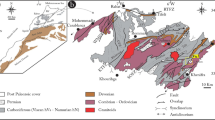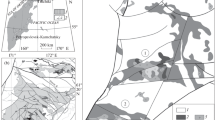Abstract
The Birushin monzonite intrusion constitutes the core of a subvolcanic massif composed of crystalloclastic trachyandesites and pyroxene dioritic porphyries. The monzonites are saturated in xenoliths, which form a continuous series from micrograined pyroxene hornfelses and pyroxene microdiorites to medium-grained monzodiorites and monzonites. Xenoliths of different composition and texture occur together within limited areas, thus providing the impression of their transportation from different sources. At the same time, some xenoliths are multiphase and consist of three or more zones of different composition. The micrograined melanocratic xenoliths are characterized by trachytoid alignment of plagioclase and amphibole grains. Numerous measurements have revealed a persistent orientation of trachytic textures. Based on structural, chemical, and mineral data, it has been concluded that the core monzonites were formed by magmatic replacement in situ of the host crystalloclastic trachyandesites and dioritic porphyries.
Similar content being viewed by others
References
V. V. Akinin, J. Hourigan, J. Wright, E. Miller, and L. F. Mishin, “New age isotope data on the Okhotsk-Chukotka volcanic belt (U-Pb SHRIMP-dating),” in Proceedings of Conference on Isotope Dating of Ore Formation, Magmatism, Sedimentation, and Metamorphism, Moscow, Russia, 2006 (IGEM RAN, Moscow, 2006), Vol. 1, pp. 22–26 [in Russian].
G. A. Valui, Feldspars and Conditions of Granitoid Crystallization (Coastal Zone of Primorye) (Nauka, Moscow, 1979) [in Russian].
S. N. Gavrikova and V. A. Zharikov, “Geochemical features of the granitization of Archean rocks in East Transbaikalia,” Geokhimiya, No. 1, 26–19 (1984).
V. A. Zharikov, “Problems of Granite Formation,” Vestn. Mosk. Gos. Univ. Ser. 4: Geol., No. 6, 3–14 (1987).
V. A. Zharikov and S. N. Gavrikova, “Granite formation in the activated margin of the Aldan-Stanovoy Shield,” Zap. Ross. Mineral. O-va 116(4), 377–399 (1987).
V. A. Zharikov and L. I. Khodorevskaya, “Generation of granites after amphibolites,” Petrology 14(4), 319–336 (2006).
D. S. Korzhinskii, “Granitization as magmatic replacement,” Izv. Akad. Nauk SSSR, Ser. Geol., No. 2, 332–452 (1952).
S. P. Korikovsky, Metamorphism, Granitization, and Postmagmatic Processes in the Precambrian of the Udokan-Stanovoy Zone (Nauka, Moscow, 1967) [in Russian].
S. P. Korikovsky and L. I. Khodorevskaya, “Granitization of Paleoproterozoic high-pressure metagabbronorites of the Belomorian Group in Gorelyi Island, Kandalaksha Bay Area, Baltic Shield,” Petrology 14(5), 423–451 (2006).
F. A. Letnikov, S. O. Balyshov, and V. V. Lashkevich, “Interrelations among the processes of granitization, metamorphism, and tectonics,” Geotectonics 34(1), 1–18 (2000).
V. A. Magnitskii, Sh. A. Mukhamediev, and R. Kh. Khasanov, “The possibility of rock melting in the Earth’s crust during intense folding: evidence from the Pamirs,” Dokl. Earth Sci. 363A(9), 1292–1296 (1998).
L. F. Mishin, Subvolcanic Felsic Intrusions (Nauka, Moscow, 1994) [in Russian].
L. F. Mishin, “Eutectoid and cotectoid petrographic types of acid volcanic and subvolcanic rocks of the continental margin volcanic belts as exemplified by East Asia,” Russ. J. Pac. Geol. 3(2), 169–184 (2009).
L. F. Mishin, “Eu geochemistry in magmatic rocks of continental marginal volcanic belts,” Geochem. Int. 48(6), 580–592 (2010).
L. F. Mishin, “Conditions of the formation of hypabyssal granitoid intrusions using the example of the Sizindzha Massif, the Okhotsk-Chukotka volcanic belt,” Russ. J. Pac. Geol. 7(1), 16–25 (2013).
L. F. Mishin, V. V. Akinin, and E. A. Ryabova, “Problem of space for subvolcanic and hypabyssal granitoids,” in Tectonics, Deep Structure, and Mineralogy of East Asia. Proceedings of All-Russian Conference, 8th Kosygin Reading, Khabarovsk, 2013 (Dal’nauka, Vladivostok, 2013), pp. 78–81 [in Russian].
L. F. Mishin, Chzhao Chuntszin, and A. I. Soldatov “Mesozoic-Cenozoic volcanoplutonic belts and systems in the continental part of East Asia and their zoning,” Tikhookean. Geol. 22(3), 28–47 (2003).
P. L. Nevolin, V. P. Utkin, and A. N. Mitrokhin, “The Tafuinsky granite massif, Southern Primorye Region: the structures and geodynamics of longitudinal compression,” Russ. J. Pac. Geol. 4(4), 331–346 (2010).
P. L. Nevolin, V. P. Utkin, A. N. Mitrokhin, and T. K. Kutub-Zade, “Geologic structure of Western Primorye: structuring dynamics,” Russ. J. Pac. Geol. 6(4), 17–37 (2012).
H. Ramberg, Gravity, Deformation, and the Earth’s Crust (Studied by Centrifuged Model) (Akad. Press, New York, 1967) [in Russian].
L. I. Khodorevskaya, V. M. Shmonov, and V. A. Zharikov, “Granitization of amphibolites. 1. Results of first experiments with fluid filtering through rock,” Petrology 11(3), 291–300 (2003).
L. I. Khodorevskaya, “Granitization of amphibolites: 2. Characterization of physical and chemical phenomena related to fluid filtration through a rock,” Petrology 12(3), 282–295 (2004).
L. I. Khodorevskaya, “Fluid regime and the behavior of ore, trace, and rare-earth elements during granitization of metagabbronorites of the Belomorian Group (Gorelyi Island, Kandalaksha Bay),” Petrology 17(4), 371–388 (2009).
A. Castro, “On granitoid emplacement and related structures. A review,” Geol. Rundsch. 76(1), 101–124 (1987).
B. W. Chappell, C. J. Bryant, D. Wyborn, A. J. R. White, and I. S. Williams, “High- and low-temperature I-type granites,” Resource Geol. 48(4), 225–235 (1998).
B. W. Chappell and D. Wyborn, “Cumulate and cumulative granites and associated rocks,” Resource Geol. 54(3), 227–240 (2004).
R. A. Daly, “The mechanics of igneous intrusions,” Am. J. Sci., No. 13, 107–126 (1903).
J. Didier, Granites and their Inclusions, the Bearing of Inclusions on the Origin of Granites (Elsevier, New York, 1973).
J. Didier, “Contribution of enclave studies to the understanding of origin and evolution of granitic magmas,” Geol. Rundsch. 76, 41–50 (1987).
T. Furman and F. J. Spera, “Co-mingling of acid and basic magma with implications for the origin of mafic I-Type xenoliths: field and petrochemical relations of an unusual dike complex at Eagle Lake, Sequoia National Park, California, USA,” J. Volcanol. Geotherm. Res. 24, 151–178 (1985).
A. Gansser and T. Gyr, “Über Xenolithschwarmeäus dem Bergeller Massiv und probleme der intrusion,” Eclogae Geol. Helv. 57(2), 577–598 (1964).
G. Gastil, “The boundary between magnetite-series and ilmemte-series granitic rocks in Peninsular Cali fornia, in Recent Advances in Concepts Concerning Zones Plutons in Japan and Southern and Baja California (Tokyo, 1990), pp. 91–100.
J. S. Mayers, “Cauldron subsidence and fluidization mechanisms of intrusion of coastal batholith of Peru into its own volcanic ejecta,” Geol. Soc. Am. Bull. 86(9), 1209–1220 (1975).
K. R. Mehnert and W. Busch, “The formation of K-Feldspar megacrysts in granites, migmatites and augengneisses,” Neues Jahrb. Miner. 151, 229–259 (1985).
K. R. Mehnert, “50 Jahre Gramtforschung,” Geol. Rundsch. 76(1), 1–14 (1987).
H. I. Neugebauer and C. Reuther, “Intrusion of igneous rocks-physical aspects,” Geol. Rundsch. 76(1), 89–99 (1987).
W. S. Pitcher, “The migmatic older granodiorite of Thorr District, Co. Donegal,” Quat. J. Geol. Soc. 430, 413–447 (1952).
W. S. Pitcher and H. H. Read, “On the Main Donegal Granite,” Quat. J. Geol. Soc. London, 114, 259–305 (1958).
C. E. Wegmann, “Ubersicht uber die geologie des Felsgrundes im Kustengebier Zwischen Helsmgfors und Onas,” Bull. Com. Geol. Finland 89, 1–15 (1935).
Author information
Authors and Affiliations
Corresponding author
Additional information
Original Russian Text © L.F. Mishin, V.G. Nevstruev, E.A. Ryabova, V.S. Komarova, 2015, published in Tikhookeanskaya Geologiya, 2015, Vol. 34, No. 3, pp. 17–31.
Rights and permissions
About this article
Cite this article
Mishin, L.F., Nevstruev, V.G., Ryabova, E.A. et al. Conditions of formation of the birushin monzonite intrusion, Sikhote Alin. Russ. J. of Pac. Geol. 9, 178–192 (2015). https://doi.org/10.1134/S1819714015030057
Received:
Published:
Issue Date:
DOI: https://doi.org/10.1134/S1819714015030057




